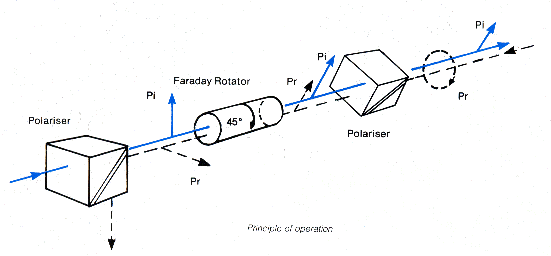The Faraday or Magneto-Optic Effect

First described in 1845 by Michael Faraday, the eponymously named effect occurs in most optically transparent dielectric materials (including liquids) when they are subject to strong magnetic fields. The effect, manifested as an induced optical activity, is able to rotate the plane of polarization of an input optical beam which propagates parallel to the direction of the magnetic field in the material.
The strength of the effect is simply given by the formula theta=BVl where theta is the angle of rotation; B is the magnetic field in tesla, V is the verdet constant for the material and l is the effective length of material contained within the magnetic field (although due to the nature of most practical magnetic fields, this can sometimes be difficult to ascertain with any certainty).
Unlike the electro-optic effect, the magneto-optic effect causes a true rotation of the plane of polarization for any input polarization angle. In a simple electro-optic device, only pure rotations of 90° are available; all other intermediate voltages produce different degrees of elliptical polarization states from a linear input state. A Faraday rotator however will truly rotate the plane of input polarization through any angle (providing you can provide a strong enough magnetic field!
The verdet constant for most materials is extremely small and is wavelength dependent. The effect is at its strongest in those substances containing paramagnetic ions such as terbium. The highest verdet constants are in fact found in terbium doped dense flint glasses and better still in crystals of terbium gallium garnet (TGG). Although expensive, this material has significant benefits over glasses and other substrates, notably excellent transparency, high optical quality and very high resistance to laser damage. All of Leysop’s Faraday rotators are manufactured from the highest quality crystals of TGG because of this.
Although the Faraday effect is not itself chromatic, the verdet constant itself is quite strongly a function of wavelength. At 632.8 nm, the verdet constant for TGG is reported to be
-134 rad/T-1/m whereas at 1064 nm, it has fallen to -40 rad/T-1/m. This behavior means that the devices manufactured with a certain degree of rotation at one wavelength, will produce much less rotation at longer wavelengths.
Our rotators and isolators are all user adjustable by varying the degree to which the active TGG rod is inserted into the magnetic field produced by an extremely strong permanent magnet. In this way, the device can be tuned for use with a range of lasers within the design range of the device. Truly broadband sources (such as ultra-short pulse lasers and the tunable vibronic lasers) will not see the same rotation across the whole wavelength band as a result. We do however intend in the near future to launch a range of devices which offer a well balanced performance simultaneously over the wavelength range of operation of the important Ti:sapphire laser. This is achieved by the use of a Faraday rotator with a carefully selected and matched passive optical rotator plate.
Applications of Faraday Devices

The most common application for a Faraday rotator is when coupled with input and output polarizers to form an isolator. The rotation is then set at 45°. The key property of a Faraday rotator which distinguishes it from say a quartz rotation plate, is that the effect is uni-directional. A device which produces a clockwise rotation of the optical beam’s polarization axis through 45° when the beam propagates in one direction, will not reverse this effect for a beam passing back in the opposite direction, will produce an additional rotation of 45° for the reverse beam. This will then be at 90° to the input polarization axis. This is demonstrated in the illustration below:

In the form of isolator shown, the rejected beams is not used and is simply discarded (in most applications it is not necessary to use a polarizer with a side exit face, scattering of the rejected beam is sufficient). This would for example be suitable when only rejection of back-reflected radiation is required. One could however make use of these beams to form an optical circulator by the addition of a few extra components.
The commonest use of Faraday isolators is in preventing laser oscillators from being damaged by strong back reflections from subsequent optics and especially from certain types of amplifiers where a significantly enhanced back reflection may occur. They are also useful in preventing unwanted feedback from reducing the stability of line narrowed single frequency sources through mode pulling. Rotators are also used for example in ring laser systems to introduce a loss mechanism (in conjunction with some other intra-cavity polarization selective element) which is greater for one direction of propagation than for the other. This ensures uni-directional response. Usually such devices are not required to work at such high rotation angles as the 45° found in isolators so may be made much smaller.
So if you think your laser system is suffering from the effects of back reflection, give us a call to discuss what a Faraday isolator can do for your system.
Faraday Optical Isolator Quality
People have achieved ~40dB isolation under stable conditions with the Leysop Faraday Optical Isolator. If set up optimally and held within a narrow temperature range it should certainly exceed the nominal 30dB specification.
The device has been designed to produce an extremely linear magnetic field in the TGG crystal. This is accomplished by using a larger magnet size than other FOIs. The Leysop FOI is bigger because of this.
Leysop prepares the TGG rod for minimum residual surface strain and mounts it to induce as little extra strain as possible. The photoelastic constant of TGG is reasonably high so this special mounting is important to minimize strain induced birefringence.
All of these extra features pay off. Power levels can be up to 10 – 15 W before there is a loss of isolation.
